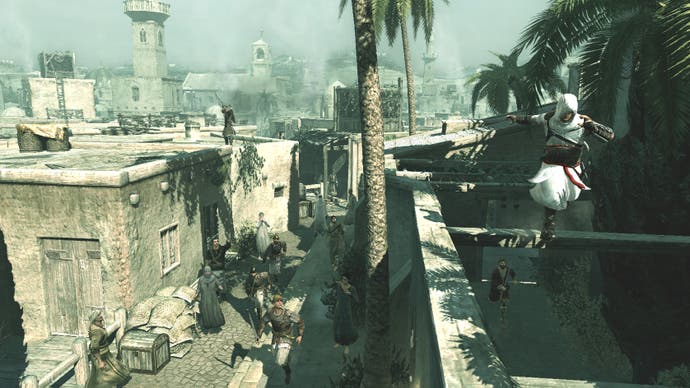Assassin's Creed
Should make a killing.
There were lots of highlights at E3 last week - running into Rutger Hauer, firing a pump-action shotgun, talking to Peter Moore about his braces - but one of the greater disappointments was Ubisoft's Assassin's Creed demo at the Microsoft conference. Having grown up in the public eye as an archly mysterious, beautifully imagined medieval kill-'em-up with more than its fair share of good ideas, it saw high-flying assassin Altair bumble onto the big screen, bounce off a few NPCs, prance across a series of beams, stab and gurn and then fire up an accent not so much west of Jerusalem as west of Adam West.
Fortunately, playing it does a better job of uncovering its accomplishments. Taking control of the same level on Xbox 360 (a PS3 version running nearby was basically identical), we got to direct Altair through the crowded streets of Jerusalem towards Talal's warehouse and the promisingly knifey climax. Beginning at one of the level's highest points, we're told how the controls map - with the analogue sticks handling movement (walking) and camera respectively, while the right trigger handles "aggression" or "high profile" moves, like running, and the face buttons perform context-sensitive actions that map to Altair's limbs. It's not all that revolutionary, mind you - A may be "feet", but that mainly just means "jump", while X and B do the arms and Y's your head.
Holding the right trigger, then, we dart to the end of a little ledge and use the A button to spring from the rooftop towards the ground and a bale of hay that we've performed a "leap of faith" to land in. Hay-bales not only break your fall but, along with benches and covered market booths and sentry posts, serve as hiding spots when guards are pursuing you through the streets; break the line of sight and leap into one and you'll be given the chance to recover your anonymity, with a flashing alert status indicator in the top-left of the screen performing the function familiar to fans of Splinter Cell and Metal Gear Solid.

But that's enough about the hay. Striding onto the streets, the crowd mechanics quickly come under scrutiny. A diamond of face buttons in the top-right of the screen flash with context-sensitive commands, making it clear that you can either gently guide them out of your way or shove people to the ground. The former's preferable, of course, not least because a morale system that governs the NPCs means that bad behaviour could come back to cause you harm later on. Side-quests, previously mentioned by Ubisoft though fenced off at E3, contribute to your standing in the community and help exert your influence more positively, as certain groups aid your flight from the law or help guide you into restricted areas later on (the monks, shown at X06, for example). The crowd's a diverse bunch, too, and occasionally home to troublemakers, who are as good as their name.
The point of our E3 mission is, as you know, to take out the chap Talal, and the first phase is about reaching his warehouse. To this end you use the mini-map, which highlights mission objectives, as well as hiding spots and other useful information, to guide your movement. In the Microsoft conference presentation, this took the player to a high place, where Altair was able to kill a rooftop guard and send him hurtling to the streets below, before sneaking past the distracted soldiers who had previously blocked the stairway to Talal's base of operations. We decide to do somewhat the same, if only to test the game's claim that you can climb everything you can see.

The first thing we do is, we're told, a common mistake - we run up the wall and grab hold of a ledge, but then send ourselves leaping away from the wall by pressing jump. You don't need to do that - you can just press up on the analogue stick to advance to the next handhold, shimmy side to side or press B to drop down again. Movement, even over complicated changing surfaces, is confident and smooth, although you may find your view slightly restricted, and certain pauses and jerks are a little jarring in light of the excellent Tomb Raider Anniversary. That said, there's still some tweaking to be done, as producer Jade Raymond acknowledged in light of the E3 demo's reception, and the more important bit is how much freedom it gives you, which is a lot.
That freedom is particularly relevant when it's coupled to the game's vaunted, parkour-influenced free-running, which allows you to dart without risk across narrow beams, and hop between arches, walls and street furniture, adding a new, untravelled gameplay path to the traditional high and low. Where it works, it's wonderfully intuitive and balletic. Where it falls down, if you'll forgive the pun, it can set you awkwardly off-balance, but that's best taken in the context of the demo's E3 setting: were we playing Assassin's Creed from the start, rather than dipping into a level that our hosts tell us is certainly not the first, we'd have more time to learn the language of the game. What's more, it's already rare to find the controls exhibiting that kind of over-sensitivity to context that made you lock onto surfaces in Gears of War when you meant to run. And for that matter, if you do threaten to stumble into an abyss, Altair spins round on the spot and clings onto the ledge.

